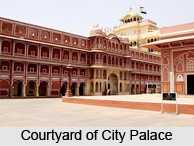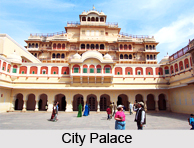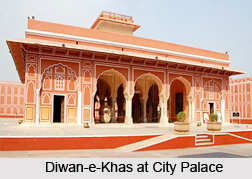 The palace was built between 1729 and 1732 AD by Sawai Jai Singh II. He ruled in Amer and planned and built the outer walls of the palace and later rulers added to the architecture of this palace. These additions have been known to take place right up to the 20th century. The urban layout of the city of Jaipur was commissioned to Vidyadhar Bhattacharya and Sir Samuel Swinton Jacob.
The palace was built between 1729 and 1732 AD by Sawai Jai Singh II. He ruled in Amer and planned and built the outer walls of the palace and later rulers added to the architecture of this palace. These additions have been known to take place right up to the 20th century. The urban layout of the city of Jaipur was commissioned to Vidyadhar Bhattacharya and Sir Samuel Swinton Jacob.
Location of City Palace
The palace is located towards the northeast side of central Jaipur and has many courtyards and buildings. The palace complex lies in the heart of Jaipur city, to the northeast of the very centre. The site for the palace was located on the site of a royal hunting lodge on a plain land encircled by a rocky hill range, five miles south of Amber (city).
History of City Palace
Maharaja Sawai Jai Singh II is known to have contracted work for building the outer wall of the city`s complex. He shifted from Ajmer to Jaipur due to water problems and an increase in population in 1727. He had endowed the city`s architectural design to the chief architect Vidyadhar Bhattacharya. The architect went on to design the City Palace in accordance with the Vaastushastra texts.
Architecture of City Palace
The City Palace reflects Rajput, Mughal and European architectural styles although the palace was designed to Vaastushastra discourse. These are all completely decorated. The Palace has been designed according to a `grid style` and has various structures such as, "Chandra Mahal", "Mubarak Mahal", "Diwan-I-Khas" and the "Govind Dev Ji Temple". The walls and gates are ornately designed to Mughal style, with various murals, lattice and mirrors embellishing them from sides.
Structures of City Palace
The most prominent and most visited structures in the complex are the Chandra Mahal, Mubarak Mahal, Mukut Mahal, Maharani`s Palace, Shri Govind Dev Temple and the City Palace Museum.
The three gates of the City palace are Rajendra Pol, Tripola Gate and Atish Pol.
Rajendra Pol: Just outside the museum of City Place one will come across the Rajendra Pol flanked by two elephants. The beasts have been carved out of a single piece of marble. This gate will lead the travelers to the inner courtyard and exquisite arches and jali windows. As the tourists proceed further another gateway awaits them-Singh Pol.
 Tripolia Gate: Towards the west of the City Palace lies the Tripolia Gate. This is a gate with three arches. This was the main entrance to the City place and Jantar Mantar. Even today only the Maharaja`s family is permitted entrance through this gate.
Tripolia Gate: Towards the west of the City Palace lies the Tripolia Gate. This is a gate with three arches. This was the main entrance to the City place and Jantar Mantar. Even today only the Maharaja`s family is permitted entrance through this gate.
Atish Pol: The other entry point for the palace is the Atish pol. It is also known as the Stable Gate. It is located to the left of palace. The Jantar Mantar (located within the place premises) could be accessed through this gate.
Besides these gates several other structures forms an important part of the grandeur in this place. They are as follows:-
Mubarak Mahal: It has been made out of white marble. This is also known as the Palace of welcome. It is a two storeyed building that can be approached from both "Sarhad ki Deorhi" and "Gainda ki Deorhi". It was built by Maharaja Madho Singh II in 1890. Originally built as a rest house it was later used as a Mahakma Khas and presently it displays the royal wardrobe as a part of the museum.
Sileh Khana: It was originally the place where the classical singers and Kathak dancers practiced their art. They also taught their disciples here. It is exactly located at Old Gunjankhana near the Mubarak Mahal. It comprises of one of the main attractions of the palace. Today it displays the antique weaponry of the Rajputs. The armory comprises of guns, glittering daggers, bows and arrows, axes and a collection of shields.
Diwan I Khas: As the name suggests it was mainly used by the royal people and the aristocrats. Laymen were not allowed here. It was built in 1730. It houses a marble gallery and it has two huge silver urns known as Gangajalis. These were used by Maharaja Madho Singh II.
 Diwan I Aam: It was built in 1760 and is popularly known as the Hall of Public Audience. In the recent times it has been converted into an art gallery. It has an exclusive collection of rare manuscripts. It is also decorated with splendid semi-precious stones studded ceilings and intricately carved pillars.
Diwan I Aam: It was built in 1760 and is popularly known as the Hall of Public Audience. In the recent times it has been converted into an art gallery. It has an exclusive collection of rare manuscripts. It is also decorated with splendid semi-precious stones studded ceilings and intricately carved pillars.
Pritam Niwas: The name literally means the house of the beloved. It was built by Jai Singh II. It faces the Jai Niwas garden.
Chandra Mahal: This is probably the most beautiful building in the palace. It has seven storeys and commands a fabulous view of the gardens and Jaipur city. The complex of the palace comprises of museum, an armory and several fine halls.
Maharani Palace
The Maharani`s Palace was originally the residence of the royal queens. It has been converted into a museum, where weapons used by the royalty during war campaigns are displayed, including those belonging to the 15th century. The ceiling of this chamber has unique frescoes, which are preserved using jewel dust of semiprecious stones. A particular weaponry on display is the scissor-action dagger, which when thrust into an enemy`s body is said to disembowel the victim, on its withdrawal. The other artifacts on display include swords with pistols attached to it, the sword presented by Queen Victoria Maharaja Sawai Ram Singh (1835-80) which is inlaid with rubies and emeralds.
The Anand Mahal Sileg Khana - the Maharani"s Palace - houses the Armoury, which has one of the best collections of weapons in the country. Many of the ceremonial weapons are elegantly engraved and inlaid belying their grisly purpose.
Govind Dev Ji Temple
Govind Dev Ji temple, dedicated to the Hindu God Lord Krishna, is part of the City Palace complex. It was built in early 18th century outside the walls set in a garden environment. It has European chandeliers and paintings of Indian art. The ceiling in the temple is ornamented in gold. Its location provided a direct view to the Maharaja from his Chandar Mahal palace. The aarti (prayer offering) for the deity can be seen by devotees only for seven times during the day.
The City Palace is a landmark in Jaipur and is also a very popular tourist hotspot. Apart from the regal architecture, the palace offers a stunning view of the Pink City and also an insight into the rich heritage of a bygone era. The City Palace is a must-see while sightseeing in Jaipur. There are palace buildings from different eras, some dating from the early 20th century. Despite the gradual development, the whole is a striking blend of Rajasthani and Mughal architecture.



















